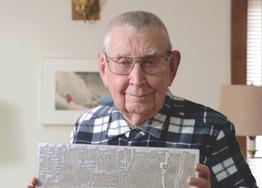
Some computer manufacturers boast that their companies built the first personal computer, but according to the Computer History Museum and others, that honor actually belongs to John Blankenbaker. Engineers were carrying slide rules in their pockets when Blankenbaker attended Oregon State in the late 1940s and early 1950s. “I gave a talk on computers in 1951 to the mathematics club, and I’ll bet that was the first time that there was a talk on computers on campus,” said Blankenbaker. Computers were in their infancy and cost thousands of dollars. Blankenbaker first attempted to design a computing device in 1949, but he abandoned the work when it became obvious to him that it would be too expensive for him to build.
He completed an internship at the National Bureau of Standards, where he was assigned to the Standards Eastern Automatic Computer project, and that experience increased his belief that computers were the wave of the future. Following graduation, Blankenbaker contributed to various computer projects for Hughes Aircraft Company while earning a master’s degree in physics from the University of California–Los Angeles. His desire to create a computer that was affordable and educational for individuals was born during those years. To round out his education, he earned a professional degree in electrical engineering from the Massachusetts Institute of Technology in 1959. After consulting for Curtis Wright, which was developing a digital training system for fleet ballistic missiles, he moved on to Scantlin Electronics to help streamline stock market data reporting. When he resigned from Scantlin, a $6,000 parting gift from the company gave him the seed money he needed to make his dream of building a small, affordable computer come true.
By September 1971, he had sold the world’s first personal computer: the Kenbak-1.“At that time, it was not very practical to use a computer to learn programming or to study computers, and that’s what I hoped to overcome with the Kenbak-1,” said Blankenbaker. “I hoped to provide a machine that was low enough in cost, though perhaps limited in capability, to provide education and fun for individuals.”The Kenbak-1 sold for $750 (about $4,470 in today’s dollars). “This was a time when the minimum price for a standalone computer was about $10,000,” said Blankenbaker. “It was not a very useful device in a business or scientific sense, because it was so small, but of course it was quite early. There were only 256 bytes of memory in the machine, and instructions were 2 bytes each, so you couldn’t have all that many instructions. But it was a very good instruction set and it tried to demonstrate what you might encounter.”
He said that his intention was to “give the flavor of a computer” so people could learn how the technology worked. Only about 50 units were produced before Blankenbaker decided that the undertaking wasn’t profitable and sold the design. Later career accomplishments included developing high-performance computers that could process up to four streams of speech for distribution over a telephone line and the production design of a Lisp processor. (Lisp was one of the earliest high-level programming languages.) After taking partial retirement in 1985, he worked part-time for Science Products, a company that made products for the blind, and taught physics and mathematics at Lincoln University.
Since 1985, Blankenbaker also has indulged his love of history and genealogy. For 15 years, he published a research journal called Beyond Germanna and other related materials covering the history of German immigrants who colonized the Piedmont area of Virginia in the 1700s.
Degrees
- B.S. Physics, 1952
- B.S. Mathematics, 1952